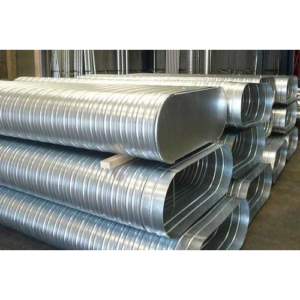What Material is used for AC Ducting? Within the realm of air conditioning systems, ducts play a critical role in transporting conditioned air throughout a building. But have you ever wondered what materials these unseen pathways are constructed from? This in-depth exploration delves into the world of AC duct materials, examining their properties, advantages, limitations, and considerations for choosing the right material for your specific needs.
The Essential Functions of AC Ducts
Air conditioning ducts act as the circulatory system of an HVAC system. They efficiently distribute cool or heated air from the central air handler to designated spaces within a building. Here are their key functions:
- Airflow Delivery: Ducts ensure conditioned air reaches all intended areas within a building.
- Pressure Management: They maintain sufficient air pressure to overcome resistance throughout the duct network and deliver air effectively.
- Thermal Insulation: Ideally, ducts are insulated to minimize heat gain or loss during air transport, maintaining temperature efficiency.
- Sound Attenuation: Duct materials can play a role in dampening noise generated by the air movement within the system.

Common AC Duct Materials and Their Properties
The choice of material for AC ducts depends on various factors like cost, installation complexity, thermal efficiency, and sound dampening properties. Here’s a breakdown of the most commonly used AC duct materials:
Galvanized Steel:
-
- Properties: The most widely used material, galvanized steel offers affordability, durability, and ease of fabrication. It provides good structural integrity and can handle high air pressure.
- Advantages: Cost-effective, readily available, and relatively easy to install.
- Limitations: Prone to thermal leaks if not properly insulated, leading to energy loss. Can be noisy due to its inherent rigidity. Susceptible to rust and corrosion if moisture condenses inside the ducts.
- Applications: Suitable for most residential and light commercial applications where cost is a primary concern.
Flexible Ducts:
-
- Properties: These ducts, typically made from aluminum foil laminated with plastic or fiberglass, offer flexibility for navigating tight spaces and around obstacles. They come pre-insulated for improved thermal efficiency.
- Advantages: Easy to install in complex layouts or retrofitting existing structures. Lightweight and flexible, allowing for easier handling and maneuvering. Pre-insulated options promote energy efficiency.
- Limitations: Not as structurally strong as rigid ducts and may require additional support to maintain their shape. Can be more susceptible to punctures or tears. May not be suitable for high-pressure applications.
- Applications: Ideal for tight spaces, attics, crawlspaces, and connecting short distances between rigid ducts and registers.
Fiberglass Board Ducts:
-
- Properties: Comprised of rigid fiberglass panels with an interior foil liner, these ducts offer good thermal insulation and sound dampening properties. They come prefabricated in sections for faster assembly.
- Advantages: Excellent thermal and acoustic insulation, promoting energy efficiency and quieter operation. Lightweight and relatively easy to handle. Prefabricated sections simplify installation.
- Limitations: More expensive than galvanized steel. May require additional sealing at joints to prevent air leaks. Susceptible to moisture damage if not properly sealed.
- Applications: Suitable for applications where noise reduction and energy efficiency are priorities, such as residential homes, offices, and healthcare facilities.
Sheet Metal Ducts:
-
- Properties: Comprised of various sheet metal options like aluminum or stainless steel, these ducts offer superior durability and fire resistance. They can be custom fabricated to fit specific needs.
- Advantages: Highly durable and long-lasting. Fire-resistant, providing an additional safety benefit. Can be custom-made for complex layouts.
- Limitations: Most expensive option among commonly used materials. Installation can be labor-intensive due to custom fabrication needs.
- Applications: Ideal for high-pressure applications, large commercial buildings, and situations where fire safety is paramount.
Additional Considerations Beyond Material Choice
While material selection is crucial, other factors influence the effectiveness of AC ductwork:
- Duct Design and Sizing: Proper duct design and sizing ensure adequate airflow throughout the system without excessive pressure drops. A qualified HVAC professional can perform these calculations to optimize ductwork performance.
- Insulation Levels: Proper insulation is crucial for minimizing energy loss during air transport. Insulation thickness recommendations depend on climate and duct location (inside vs. outside conditioned space).
- Sealing and Leak Prevention: Air leaks in ducts can significantly reduce efficiency. Proper sealing of joints and connections is essential for optimal performance.
Conclusion
What Material is used for AC Ducting? In conclusion, selecting the right material for AC ducts hinges on a comprehensive understanding of your specific needs and priorities. Here’s a quick recap of the key points to consider:
- Cost: Galvanized steel is the most budget-friendly option, while sheet metal is the most expensive. Consider the balance between upfront costs and potential long-term energy savings based on material selection.
- Installation Complexity: Flexible ducts offer the easiest installation, followed by fiberglass board and galvanized steel. Sheet metal requires custom fabrication and might be more challenging to install.
- Thermal Efficiency: Fiberglass board ducts and properly insulated flexible ducts excel in thermal efficiency, minimizing energy loss. Galvanized steel requires additional insulation for optimal performance.
- Sound Attenuation: Fiberglass board ducts excel in sound dampening, followed by flexible ducts with sound-attenuating insulation. Galvanized steel can be noisy in operation.
- Durability: Sheet metal offers unparalleled durability, followed by galvanized steel. Fiberglass board ducts are susceptible to moisture damage, while flexible ducts might be prone to punctures.
By carefully considering these factors, alongside consulting with a qualified HVAC professional, you can make an informed decision about the most suitable AC duct material for your needs. Remember, the ideal choice strikes a balance between cost, installation complexity, energy efficiency, sound control, and durability to ensure optimal performance and comfort within your building.
Looking to install a commercial HVAC System or Duct work in your Business Area?
Contact Vipul Ac to learn about our HVAC Service
Call +91 9825636606 Today.
